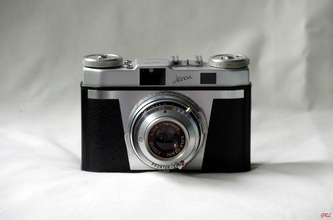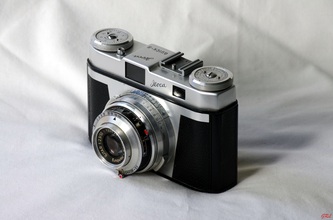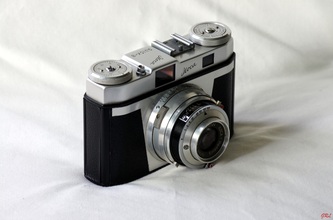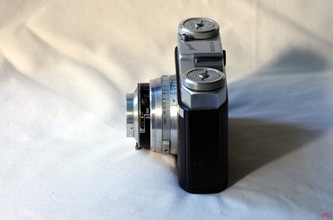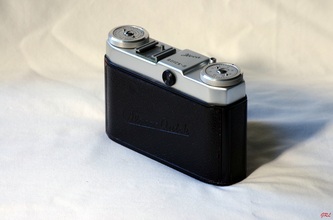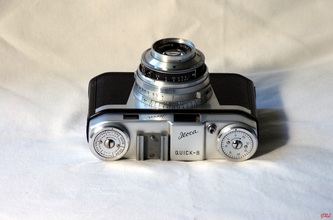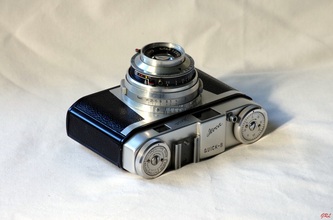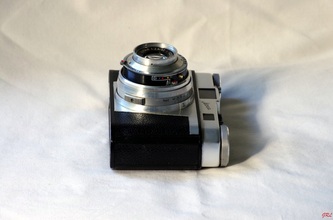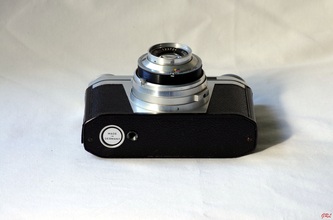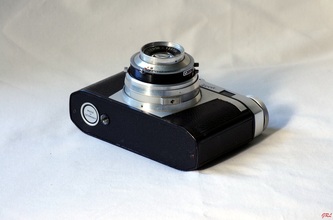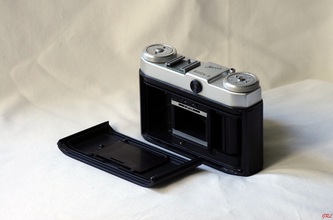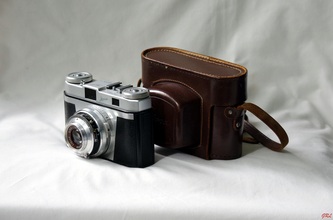Iloca Quick-B
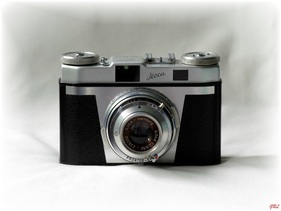
Iloca Quick-B
The Quick-B differs from its predecessors in that it shares its basic body housing with the Rapid-B, and consequently owes its heritage more to the Rapid-B than to previous Quick or Quick-A models. However, the large film advance and rewind knobs on each side of the top plate differentiate this model form the Rapid models. The Quick-B inherits the built-in rangefinder from the Rapid-B, and the overall design gives the camera a classic appearance and feel in line with other products of that era.
In keeping with the Quick philosophy, the Quick-B is fitted with an Ilitar lens, in this case a 50mm F2.9 (as opposed to the 50mm F2.8 Steinheil Cassar S in the Rapid-B). The Quick-B is also equipped with a Prontor-SV shutter. Overall, there is little difference in specification between the two models, although the Cassar lens on the Rapid-B may just edge out the Ilitar F2.9 for sharpness. Certain Quick-B models were equipped with a 50mm Ilitar F2.8 four element unsymmetrical anastigmat lens (Tessar fashion) for superior performance. And there was also a version branded Reporter which came with a Cassar S lens plus a lever attached to the film advance knob.
In many ways the real choice between the Quick-B and Rapid-B comes down to appearances, controls and layout - those looking for a classic rangefinder style camera with large film advance and rewind knobs would find that the Quick-B fits the bill. It not only feels solid, but it performs with the classic feel of a good quality camera from that period - you really do get to experience photography as it was during the '50's.
This model also incorporates the new focusing mechanism from the Rapid-B, achieved by moving the entire front lens assembly back and forward in relation to the film plane via a helical focusing mount (rather than the previous model's threaded rotating front element).
In other respects, the camera is a genuine upgrade from earlier Quick models. While it still uses a Prontor shutter (with speeds from 1 to 1/300 sec plus B), it also offers the choice of an 'M' flash setting plus the 'V' delayed action (self timer) setting. The viewfinder image is larger than the previous Quick models, but there are no dedicated framing lines, just the perimeter of the viewfinder frame. Despite the reduced image size when compared with real life, you can still achieve accurate framing and composition, with improved focusing thanks to the newly introduced built-in rangefinder. This model has no built-in metering, however the upgraded lens should give good results, with its slightly longer 50mm focal length which was a popular 'standard' on cameras of the era.
All in all, this model is well-built and pleasant to use, with an upgraded specification offering significant improvements over earlier Quick models. Due to the camera's classic feel, I'm sure it would have appealed to buyers in its day. To my knowledge, this model is the last one in the Iloca Quick range.
One tip for opening the back on these cameras: Pull the rewind knob upwards to its full extension. Then slowly turn anti-clockwise until the springloaded mechanism releases the back. When replacing the back, make sure the red dots on the camera back and the camera body are aligned.
In keeping with the Quick philosophy, the Quick-B is fitted with an Ilitar lens, in this case a 50mm F2.9 (as opposed to the 50mm F2.8 Steinheil Cassar S in the Rapid-B). The Quick-B is also equipped with a Prontor-SV shutter. Overall, there is little difference in specification between the two models, although the Cassar lens on the Rapid-B may just edge out the Ilitar F2.9 for sharpness. Certain Quick-B models were equipped with a 50mm Ilitar F2.8 four element unsymmetrical anastigmat lens (Tessar fashion) for superior performance. And there was also a version branded Reporter which came with a Cassar S lens plus a lever attached to the film advance knob.
In many ways the real choice between the Quick-B and Rapid-B comes down to appearances, controls and layout - those looking for a classic rangefinder style camera with large film advance and rewind knobs would find that the Quick-B fits the bill. It not only feels solid, but it performs with the classic feel of a good quality camera from that period - you really do get to experience photography as it was during the '50's.
This model also incorporates the new focusing mechanism from the Rapid-B, achieved by moving the entire front lens assembly back and forward in relation to the film plane via a helical focusing mount (rather than the previous model's threaded rotating front element).
In other respects, the camera is a genuine upgrade from earlier Quick models. While it still uses a Prontor shutter (with speeds from 1 to 1/300 sec plus B), it also offers the choice of an 'M' flash setting plus the 'V' delayed action (self timer) setting. The viewfinder image is larger than the previous Quick models, but there are no dedicated framing lines, just the perimeter of the viewfinder frame. Despite the reduced image size when compared with real life, you can still achieve accurate framing and composition, with improved focusing thanks to the newly introduced built-in rangefinder. This model has no built-in metering, however the upgraded lens should give good results, with its slightly longer 50mm focal length which was a popular 'standard' on cameras of the era.
All in all, this model is well-built and pleasant to use, with an upgraded specification offering significant improvements over earlier Quick models. Due to the camera's classic feel, I'm sure it would have appealed to buyers in its day. To my knowledge, this model is the last one in the Iloca Quick range.
One tip for opening the back on these cameras: Pull the rewind knob upwards to its full extension. Then slowly turn anti-clockwise until the springloaded mechanism releases the back. When replacing the back, make sure the red dots on the camera back and the camera body are aligned.
In Summary
A classic 35mm camera, with a nice feel. Robust and well-built, the model offered a good specification at a reasonable cost. It is capable of producing good results, and is a great way to experience photography from the classic '50's era.
Specifications: Iloca Quick-B
- Camera Type: 35 mm Compact Camera
- Format: 35mm film format producing image sizes 24mm x 36mm
- Shutter: Prontor–SV with speeds 'B', 1, 1/2, 1/5, 1/10, 1/25, 1/50, 1/100, 1/300 sec, with delayed action lever and M, X flash synch settings
- Lens: Jlitar 1:2.9 / 50 mm, focus range 3 feet (0.9 metre) to ∞; or Jlitar Super 1:2.8 / 50 mm Tessar Style, focus range 3 feet (0.9 metre) to ∞
- Aperture: F2.9 to F22 or F2.8 to F22 (Jlitar Super)
- Delayed Action: Approx 10 seconds (Prontor shutter model only)
- Flash Capability: Flash Contact Socket
- Frame Counter: 0 to 36
- Rangefinder: Yes
- Lightmeter: No
- Other Features: Accessory Shoe, Tripod Mount, Leather Camera Case, Instruction Manual, Box
